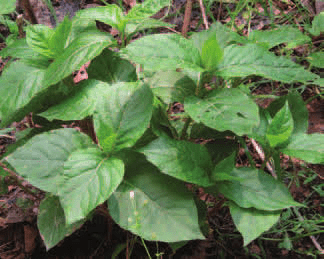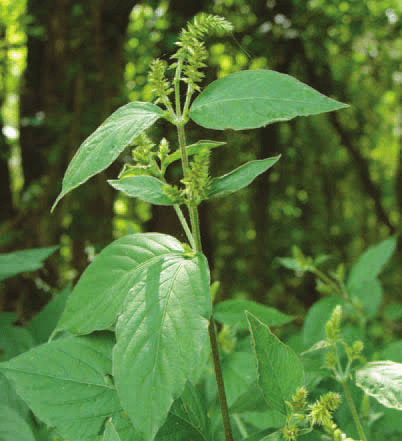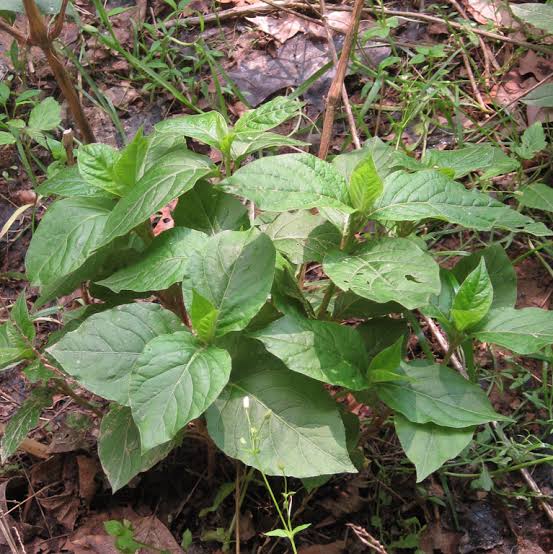Achyranthes japonica, commonly known as Japanese Chaff Flower, is a remarkable medicinal plant that has been used for centuries in traditional medicine systems across Asia. This article discuss the extensive history of its medicinal applications, providing insights into its botanical description and the various health benefits it offers.
History of Achyranthes japonica Medicinal Plant Use
1. Ancient Origins: The use of Achyranthes japonica dates back to ancient times, with records indicating its presence in traditional Chinese medicine over 2,000 years ago. It was highly valued for its diverse healing properties.
2. Traditional Asian Medicine: Throughout history, Achyranthes japonica has been a staple in the traditional medicinal practices of countries like China, Japan, and Korea. Its applications range from treating common ailments to addressing more complex health issues.
3. Ancient Texts: Ancient Chinese texts such as the “Shennong Ben Cao Jing” (Divine Farmer’s Materia Medica) mention Achyranthes japonica as a valuable herb with therapeutic uses. It was considered an essential component of herbal remedies.
4. Cultural Significance: In Korean traditional medicine, Achyranthes japonica holds cultural significance and is often included in herbal formulations. It has been used to improve overall health and wellbeing.
5. Modern Rediscovery: While modern medicine has largely shifted towards pharmaceuticals, Achyranthes japonica has experienced a resurgence of interest due to its potential health benefits. Scientific research is shedding light on its effectiveness in various applications.
6. Global Recognition: Today, Achyranthes japonica is gaining recognition beyond Asia, with herbal enthusiasts and researchers worldwide exploring its potential as a natural remedy.
The Botanical Description of Achyranthes japonica
1. Life: Achyranthes japonica is a perennial plant, which means it can live for several years, producing leaves and flowers seasonally.
2. Size: This herb typically grows to a height of 30 to 60 centimeters, making it a relatively small plant.
3. Leaves: The leaves of Achyranthes japonica are lance-shaped and arranged opposite each other along the stem. They are dark green and have a smooth texture.
4. Flowers: The plant produces small, inconspicuous flowers that are often greenish-white or pinkish in color. These flowers are clustered in dense spikes.
5. Stem: The stem of Achyranthes japonica is erect, sturdy, and often reddish-brown in color. It may branch out as the plant matures.
6. Roots: The roots of this plant are fibrous and are considered a valuable part for medicinal use. They are often used in various forms, such as dried roots or root extracts.
The Geographic Distribution of Achyranthes japonica
Achyranthes japonica, commonly known as Japanese Chaff Flower, exhibits a specific geographic distribution, primarily in East Asia. Here are six key points explaining its geographic distribution:
1. Native Range: Achyranthes japonica is native to East Asia, particularly countries such as China, Japan, and Korea. It thrives in temperate and subtropical regions.
2. China: This plant species is found in various provinces of China, including Anhui, Hubei, and Sichuan. It is often encountered in forested areas and along riverbanks.
3. Japan: Achyranthes japonica is widespread in Japan, where it is known as “Nagabou.” It can be found in both wild and cultivated environments.
4. Korea: In Korea, this herbaceous plant is commonly seen in mountainous regions and is known as “Chondro.” It has historical significance in traditional Korean medicine.
5. Naturalized in Other Regions: Due to its adaptability, Achyranthes japonica has naturalized in some regions outside of its native range, although it is most abundant in East Asia.
6. Medicinal Plant Cultivation: In recent years, efforts have been made to cultivate Achyranthes japonica in controlled environments to meet the demand for its medicinal properties.
The Chemical Composition of Achyranthes japonica
Achyranthes japonica possesses a diverse chemical composition that contributes to its medicinal value. Here are eight key components found in this plant:
1. Saponins: Achyranthes japonica contains saponins, which are known for their potential in reducing inflammation and improving cardiovascular health.
2. Alkaloids: Alkaloids present in this plant may have analgesic properties, making it valuable for pain relief.
3. Flavonoids: Flavonoids contribute to the antioxidant properties of Achyranthes japonica, helping to combat oxidative stress in the body.
4. Triterpenoids: Triterpenoids play a role in enhancing immune function and may have anti-inflammatory effects.
5. Polysaccharides: Polysaccharides found in this plant can have immunomodulatory effects, potentially benefiting the immune system.
6. Amino Acids: Certain amino acids present in Achyranthes japonica may have a calming effect on the nervous system.
7. Phenolic Compounds: Phenolic compounds contribute to the plant’s antioxidant capacity, protecting cells from damage.
8. Essential Oils: Essential oils extracted from this plant may have antimicrobial properties and are used in various traditional remedies.
The Cultivation and Growth of Achyranthes japonica
Achyranthes japonica can be cultivated for its medicinal purposes. Here are seven aspects related to its cultivation and growth:
1. Climate Requirements: This plant thrives in temperate and subtropical climates with well-defined seasons.
2. Soil Conditions: Achyranthes japonica prefers well-draining soil that is rich in organic matter. It can tolerate a range of soil types.
3. Sunlight: It requires full to partial sunlight for optimal growth.
4. Propagation: Achyranthes japonica can be propagated from seeds or by dividing established plants.
5. Growth Rate: It is a relatively fast-growing plant, especially when provided with suitable conditions.
6. Maintenance: Regular watering and occasional pruning may be required to maintain its health and shape.
7. Pest and Disease Management: While relatively hardy, it may be susceptible to certain pests and diseases that need to be managed.
The Harvesting and Processing of Achyranthes japonica
Harvesting and processing Achyranthes japonica is a crucial step in utilizing its medicinal properties. Here are six considerations in this regard:
1. Harvesting Time: The optimal time to harvest varies depending on the part of the plant used. Roots are typically harvested in the fall or spring, while leaves and stems are collected during the growing season.
2. Drying: After harvesting, the plant parts are dried to preserve their active compounds. Proper drying techniques are essential to maintain quality.
3. Root Extraction: For medicinal use, the roots are often extracted to obtain active compounds. This can be done using various methods, such as decoction or tincture preparation.
4. Quality Control: It’s crucial to ensure the quality and purity of the harvested plant material, especially for medicinal purposes.
5. Traditional Methods: Traditional herbalists may follow specific techniques and rituals during harvesting and processing to enhance the plant’s efficacy.
6. Modern Processing: In commercial settings, modern processing techniques, including extraction and encapsulation, may be employed to create standardized herbal products.
Read Also: 15 Medicinal Health Benefits of Castanea sativa (Sweet Chestnut Tree)
The Medicinal Health Benefits Of Achyranthes japonica (Japanese Chaff Flower)

Achyranthes japonica, commonly known as Japanese Chaff Flower, offers a wide range of medicinal health benefits. Here are 17 of its notable advantages:
1. Anti-Inflammatory Properties: Achyranthes japonica has anti-inflammatory effects, making it beneficial for conditions associated with inflammation, such as arthritis.
2. Pain Relief: It can provide pain relief, especially for musculoskeletal pain and joint discomfort.
3. Blood Pressure Regulation: This plant has been studied for its potential to help regulate blood pressure levels.
4. Antioxidant Activity: Achyranthes japonica contains antioxidants that protect cells from oxidative stress and damage.
5. Immune Support: It may enhance the immune system, helping the body defend against infections.
6. Bone Health: Some studies suggest that it could support bone health and may be useful in managing osteoporosis.
7. Cardiovascular Health: It may contribute to cardiovascular health by improving blood circulation and reducing cholesterol levels.
8. Anti-Diabetic Effects: Research has shown potential in using Achyranthes japonica to manage diabetes.
9. Anti-Cancer Properties: Preliminary studies indicate that it may have anticancer properties, though further research is needed.
10. Liver Health: It may support liver function and aid in detoxification processes.
11. Kidney Health: Achyranthes japonica has been traditionally used to promote kidney health and prevent kidney-related issues.
12. Anti-Aging Benefits: Its antioxidant content may help reduce signs of aging, such as wrinkles and skin blemishes.
13. Digestive Health: It can aid in digestion and alleviate gastrointestinal discomfort.
14. Stress Reduction: Some compounds in this plant may have a calming effect on the nervous system, reducing stress and anxiety.
15. Wound Healing: Achyranthes japonica has been applied topically to promote wound healing and reduce inflammation in skin injuries.
16. Respiratory Health: It may be beneficial for respiratory conditions, such as asthma and bronchitis.
17. Menstrual Health: In traditional medicine, it has been used to address menstrual irregularities and discomfort.
Methods of Usage to Achieve the Provided Health Benefits Of Achyranthes japonica (Japanese Chaff Flower)
To harness the health benefits of Achyranthes japonica, various methods of usage can be employed. Here are seven common approaches:
1. Herbal Tea: The leaves or roots can be used to prepare a soothing herbal tea that provides many of the plant’s benefits.
2. Capsules and Supplements: Achyranthes japonica is available in supplement form, providing a convenient way to incorporate it into your daily routine.
3. Topical Applications: For skin issues and wound healing, create a poultice or cream using Achyranthes japonica extract.
4. Tinctures: Tinctures made from this plant are concentrated extracts that can be taken orally or added to beverages.
5. Traditional Medicine: In traditional Asian medicine, practitioners may prescribe specific formulations containing Achyranthes japonica.
6. Culinary Use: Some cultures incorporate Achyranthes japonica into culinary dishes, although its medicinal effects may be less pronounced when cooked.
7. Aromatherapy: Inhaling the aroma of Achyranthes japonica essential oil may have calming effects.
Side Effects Of Using Achyranthes japonica Medicinal Plant
While generally safe, there are potential side effects associated with the use of Achyranthes japonica:
1. Allergic Reactions: Some individuals may be sensitive to this plant and experience allergic reactions, such as skin rashes or itching.
2. Digestive Issues: Excessive consumption may lead to digestive discomfort, including diarrhea or stomach cramps.
3. Blood Pressure: Those with low blood pressure should use it cautiously, as it may further reduce blood pressure levels.
4. Pregnancy and Nursing: Pregnant and nursing women should consult a healthcare professional before using Achyranthes japonica.
5. Drug Interactions: It may interact with certain medications, so it’s essential to consult a healthcare provider if you are taking prescription drugs.
6. Not for Prolonged Use: Long-term use should be monitored, as it may lead to adverse effects.
7. Avoid in Children: It is not recommended for use in children without the guidance of a healthcare professional.
8. Dosage Considerations: Proper dosage and administration should be followed to minimize potential side effects.
Read Also: 6 Medicinal Health Benefits of Opium Poppy (Papaver Somniferum)
Scientific Research and Studies of Achyranthes japonica

Achyranthes japonica has been the subject of scientific research, which has provided valuable insights into its medicinal properties. Here are eight areas of scientific investigation:
1. Anti-Inflammatory Activity: Numerous studies have explored its anti-inflammatory effects and mechanisms of action.
2. Antioxidant Potential: Research has examined its antioxidant capacity and its role in preventing oxidative stress-related diseases.
3. Osteoporosis Management: Studies have investigated its potential in managing osteoporosis and improving bone health.
4. Anticancer Properties: Some studies have explored its potential as an anticancer agent, focusing on specific compounds.
5. Diabetes Management: Research has examined its effects on blood sugar levels and its potential in diabetes management.
6. Cardiovascular Benefits: Scientific investigations have explored its impact on heart health, including blood pressure regulation and cholesterol reduction.
7. Immune System Modulation: Studies have investigated its influence on immune system function and its ability to enhance immune responses.
8. Safety and Toxicology: Research has assessed its safety profile and potential toxicity levels, providing valuable information for users.
Safety Precautions and Recommendations In Using Achyranthes japonica Medicinal Plant
When using Achyranthes japonica (Japanese Chaff Flower) for its medicinal benefits, it’s essential to follow safety precautions and recommendations to ensure its proper and safe utilization. Here are eight important precautions and recommendations:
1. Consult a Healthcare Professional: Before using Achyranthes japonica for medicinal purposes, consult a healthcare provider, especially if you have underlying medical conditions or are taking medications.
2. Dosage Guidance: Follow recommended dosages provided by healthcare professionals or on product labels. Do not exceed the recommended dose.
3. Allergy Testing: If you have a history of plant allergies, perform a patch test before using Achyranthes japonica topically to check for allergic reactions.
4. Avoid Prolonged Use: Long-term use of Achyranthes japonica should be monitored, and it is generally advisable to take breaks to prevent potential side effects.
5. Pregnancy and Nursing: Pregnant and nursing women should avoid using Achyranthes japonica without consulting a healthcare provider due to limited safety information.
6. Interaction with Medications: Be cautious if you are taking medications, as Achyranthes japonica may interact with certain drugs. Consult a healthcare professional for guidance.
7. Monitor Blood Pressure: If you have low blood pressure, be vigilant when using Achyranthes japonica, as it may further lower blood pressure levels.
8. Adhere to Usage Guidelines: Follow recommended methods of usage and avoid excessive consumption, as misuse may lead to adverse effects.
Legal Status and Regulations In Using Achyranthes japonica Medicinal Plant
The legal status and regulations regarding the use of Achyranthes japonica (Japanese Chaff Flower) as a medicinal plant can vary by region and country. Here are seven factors to consider:
1. Traditional Medicine Recognition: In some countries, Achyranthes japonica may be recognized as a traditional herbal remedy and regulated accordingly.
2. Herbal Supplement Laws: Depending on the region, it may be classified as an herbal supplement, subject to regulations governing dietary supplements.
3. Restricted Herbs: In certain areas, specific regulations restrict the sale or use of certain herbs, including Achyranthes japonica, due to concerns about safety or conservation.
4. Quality Control: Products containing Achyranthes japonica should meet quality and safety standards established by regulatory agencies, ensuring purity and potency.
5. Labeling Requirements: Regulations often require clear and accurate labeling of products containing Achyranthes japonica, including dosage instructions and potential side effects.
6. Import and Export Rules: For international trade, the import and export of Achyranthes japonica may be subject to additional regulations and permits.
7. Research and Documentation: The legal status may be influenced by scientific research and documentation of its safety and efficacy.
FAQs About Achyranthes japonica Medicinal Plant
Here are 14 frequently asked questions (FAQs) about Achyranthes japonica (Japanese Chaff Flower) as a medicinal plant:
1. What is Achyranthes japonica?
Achyranthes japonica is a medicinal plant known for its various health benefits.
2. How is it used medicinally?
It can be used in various forms, including herbal teas, capsules, tinctures, and topical applications.
3. Is it safe to use Achyranthes japonica?
When used as directed and with proper precautions, it is generally considered safe. Consult a healthcare professional for guidance.
4. What are the potential health benefits?
Achyranthes japonica may provide benefits such as anti-inflammatory effects, pain relief, and support for bone and cardiovascular health.
5. Can it be used for skin issues?
Yes, it can be applied topically for wound healing and skin inflammation.
6. Are there any side effects?
While generally safe, it may cause allergic reactions or digestive discomfort in some individuals.
7. Can pregnant women use it?
Pregnant women should consult a healthcare provider before use due to limited safety data.
8. Does it interact with medications?
It may interact with certain medications, so consult a healthcare provider if you are taking prescription drugs.
9. How should I store Achyranthes japonica products?
Store them in a cool, dry place away from direct sunlight.
10. Can I grow Achyranthes japonica at home?
It can be cultivated, but proper care and environmental conditions are required.
11. Is Achyranthes japonica legal in my country?
The legal status varies by region and country, so research your local regulations.
12. Where can I purchase Achyranthes japonica products?
You can find them at herbal stores, online retailers, and health food stores.
13. What is the recommended dosage for Achyranthes japonica?
Dosages may vary based on the form and product. Follow label instructions or consult a healthcare provider.
14. Are there ongoing scientific studies on Achyranthes japonica?
Yes, research on its medicinal properties and safety is ongoing, contributing to our understanding of its benefits and risks.
Read Also: How To Educate Yourself On Climate Change

